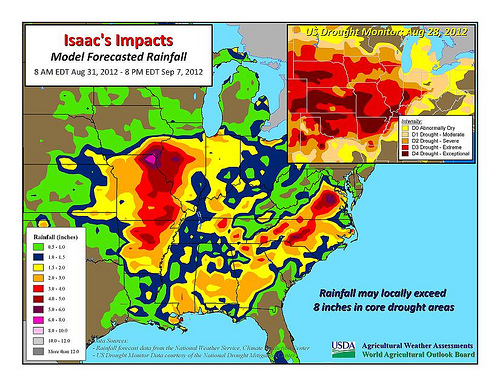
Isaac's Impacts: Model Forecasted Rainfall, August 31, 2012. Click to enlarge image.
Visit www.usda.gov/drought for the latest information regarding USDA’s Drought Disaster response and assistance.
Hurricane Isaac has grabbed most of the weather headlines in recent days, but drought remains deeply entrenched across nearly two-thirds of the continental United States. According to the latest U.S. Drought Monitor, dated August 28, drought covered 62.9% of the Lower 48 states, down only slightly from a peak of 63.9% on July 24. However, during the five-week period from July 24 to August 28, the portion of the country in exceptional drought (D4) increased from 2.4 to 6.0%. Read more »

Harvest day at the Cotton Patch, a People’s Garden in Memphis, Tenn. The cucumbers, okra, radishes and squash harvested by USDA employees and community members are all donated to the Mid-South Food Bank. Photo courtesy Jeff Carnahan, Agricultural Marketing Service
This summer, the Cotton Division of USDA’s Agricultural Marketing Service (AMS) established a People’s Garden in Memphis, Tenn. The garden, suitably named “the Cotton Patch,” is a collaborative project developed and maintained by USDA employees and residents in the surrounding community. The exotic garden features raised vegetable beds and a colorful Japanese maple tree, as well as flower and rose gardens. Read more »
Whether in a school setting or at home, when you involve kids with food preparation, you open the door to a healthy future. Kids learn that it’s fun and easy to create healthy meals and snacks. They receive the benefits of fruits and vegetables as they explore different flavors and textures, and they gain knowledge and skills that will last a lifetime.
So, parents, let your kids dig in as you spend time together in the kitchen. Teachers, use food to keep your students engaged while learning across several subjects. Need some suggestions? Nutrition.gov can help. Read more »
As Americans celebrate Labor Day this weekend, I know the holiday is overshadowed by a drought that has been extremely challenging for thousands of farm and ranch families.
President Obama and I will continue to do all we can to help drought-stricken producers. In a nation where one of every 12 jobs is supported by agriculture, we know that it’s critical to help farmers, ranchers and producers mitigate the effects of drought and continue to strengthen the agriculture sector.
Meanwhile we will continue to call on Congress to pass a comprehensive, multi-year Food, Farm and Jobs Bill – to give USDA tools to help drought stricken producers, and to give more certainty to farmers and ranchers.
But even in a challenging time, American agriculture has stayed strong and resilient. That’s why, as we gather with family and friends to mark Labor Day, it couldn’t be a more appropriate time to say “Thank You” to the folks who provide the most affordable, the most abundant, and the safest food supply on earth. Read more »
Recently, representatives of USDA Rural Development and other federal agencies held a collaboration meeting with the federally recognized tribes of the Ahtna Region, Alaska. The meeting was the fourth in a series of government-to-government Tribal Collaboration Meetings scheduled with tribes in Alaska. The venue for the meeting between federal officials and tribal leaders was in the beautiful remote Copper River valley at the Tazlina Community Hall. Tazlina is located seven miles south of Glennallen on Alaska’s Richardson Highway.
Tribal representatives and other partners from the region used the session in early August to discuss issues affecting their villages. Leaders from Rural Development, the Natural Resources Conservation Service, Farm Service Agency, Small Business Administration, Housing and Urban Development and the Economic Development Administration (EDA) were on hand to listen and participate in the dialogue. Read more »
The First Stewards: Coastal People Address Climate Change symposium was recently held in Washington, D.C. This meeting brought coastal area Native Americans, Alaska Natives and indigenous U.S. Pacific Islanders together with scientists, non-governmental organizations and policy makers to discuss the impacts of, and develop collaborative solutions to, climate change.
Adaptation to climate change is a pressing issue for indigenous people, who have lived closely with the ocean and coastal land for generations and depend on them for cultural survival.
The Quinault Indian Nation, Quileute Nation, Makah Nation and Hoh Tribe hosted a gathering of over 300 people July 17–20 at the National Museum of the American Indian.
One of the panels was moderated by an employee of USDA’s Natural Resources Conservation Service (NRCS), Ciro Lo Pinto, District Conservationist in Wellsboro, Penn. As part of the discussion, he shared the new Indigenous Stewardship Methods and NRCS Conservation Practices Guidebook. Read more »


